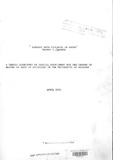| dc.description.abstract | The study empirically examines robbery with violence not as an isolated criminal event, but as a reflection of conflicting property relations within the Kenyan Society. Thus robbery with violence is viewed as a likely outcome of interaction between the propertied and non-propertied classes.The main areas of the study involve; the underlying conditions influencing robbery with violence in Kenya, the distribution of the
violent robbers in the socio-economic arena, the real and/or latent motives of injurious violence on the victims during robbery, and the offenders' attitudes in relation to the perceived socio-economic reality in which they live and operate. The paper also examines the habitual and non-habitual robbers in terms of the family background
from where they originated. The data analysis seems to support the view that robbery with violence is not independent of the existing social structure and
that violent robbers are not necessarily originating from the poorest of the society. However, a proportionately large number of the low class is more involved in robbery with violence because of restricted access to material prosperity due to low education, low incomes, joblessness and other economic deprivations. The findings
therefore imply that socio-economic disparity is the main determinant of engagement in robbery with violence. An equally important finding is that victims' resistance is crucial
in determining the occurrence of physically injurious violence inspite of whether or not the robbers are heavily or lightly armed during the raid.It is recommended that more liberal policies be designed to maintain full employment and promote equality of opportunities which would facilitate the integration of masses of jobless people into the
economic mainstream. There should be easy access to education, wealth, employment without discrimination hence reducing economic frustrations which lead to exploration of illegal property ownership. Employment can easily be created by government's
commitment to bottom-up development activities which include rural
electrification, roads construction, state firms all of which would indiscriminately absorb both the literate and illiterate persons idling about in the urban areas and countryside.
The study was undertaken in four principal prisons in Kenya namely, Kamiti, Naivasha, Shimo-la-Tewa and Kisumu (Kodiaga). Using a proportionate random sampling, data was gathered from 200 convicted violent robbers, 30 convicted murderers and 35 convicted rapists. Finally, the Thesis has brought into focus the existence of diverse
criminological thoughts and the writer's minimum aim will have been achieved if it acts as a starting point for further research on the increasing crimes against property in Africa. | en |

